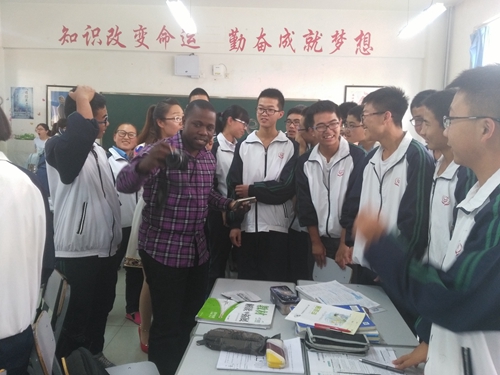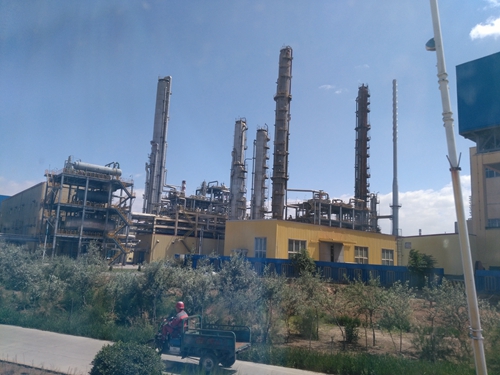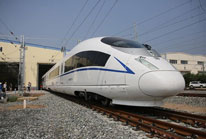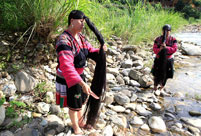

Only the well informed knows that China is a terribly challenged country, ecologically.
When flying from Beijing or any of the cities of the east towards the North West or central China, the signs of the contrast are so visible.
Towards the north central, a little after take-off from Beijing, it’s a stretch of high mountain ranges that takes about 20 minutes to overfly. Immediately after the mountains heading to the Ningxia Hui Autonomous Region is a stretch of desert that is continuous to the northern tip of the country.

Resettlement village for the poor people (Photo/Ikenna Emewu)
From Yinchuan, the capital city of Ningxia, the 45 minutes of flight to Xi’an, capital city of the central province of Shaanxi, is just over desert sand dunes. Ningxia and other adjacent provinces are right inside the desert. Data of China population distribution reveals that 400m of the people live in semi or total arid zones.
Within this almost impossible environment, through sheer determination and ingenuity, Ningxia is eking out rapid and successful developments over the years. From crushing poverty, the autonomous region reputed for the poorest axis of China, has between 1982 and 2015 lifted 2.9m of the people from dire conditions. These are facts revealed by the government of the province during a recent visit.
At the stocktaking of leadership of the country in March, Premier Li Keqiang during the Two Sessions had declared that China lifted 14.3m people out of poverty nationwide last year.
Ningxia and the other worst affected areas are part of this awesome project that made China the only developing country in the world to meet the UN Millennium Development Goal on poverty reduction in the past two years.
Yet, the project continues.
It was amazing listening to the success story of Ningxia during a meeting with the government of the provincial region. From one policy to the other, there was the same streak of successes.
They include the biggest challenge of the zone which is the desert threat from all fronts. It is so bad that some years ago, the UN mandated China to relocate the hundreds of communities scattered in the desert to new places because the locations were uninhabitable. The only option to salvage their cases of poverty was moving them to better and conducive parts of the region. This was simple according to the Secretary of the CCP in the region because no individual owns lands in China.
To accomplish this, over 1.2m people had at the last batch benefitted. That has been on in the past decade. They got new homes built for them by the government and located by the banks of the Yellow River, the life blood of the region.
One of them, Heshun Village is very close to Yinchuan with amenities, including a special school for their children and a middle school that has over 3000 students with all the students on free education. It is a model school by all standards.
The proud principal of the school, Yang Jing explained with pride in her eyes and voice, the achievements of the school.

African fellow with kids of resettled persons in their school
The Yucai Middle School has become a place of excellence in so many ways. Through that project, children of the areas made of minority ethnic groups such as the Hui and some smaller others, have the rare access to admission into the best universities in China. On the notice board of the school is the photo of a teenage boy who made record last year as the first from his ethnic group to be admitted into a university in Beijing. Records of the school’s academic achievements on the notice board indicated that 93.7% of the graduates last year gained admissions into universities and 5% of them into artisanship trainings.
At the Heshun resettlement quarters, there are 750 families all proud owners of their new homes and farmlands from the government near the river through which they have access to irrigation. Those that would not engage in farming are trained in some other trades like construction and artisanship and as government handles constructions of even infrastructure for them, they are employed and paid and with time they get qualified to live on their trades and training.

African fellow with kids of resettled persons in their school
Battling desertification
Ningxia government coached that since 1953 when China started the first opening up, the government launched a project to contain desertification of Ningxia that lives constantly under ravaging desert encroachment. In these years, the province during the visit to the desert said that it has reclaimed 10.8m sq/m of desert land and most of it converted to farmlands.
This year, the province detailed specific targets of poverty reduction for the next two years including “liberating 580,000 very poor people from 80 villages by relocating them and increasing their disposable income rate to 10,000 yuan per person per year by 2020. The projects are in five major areas with the first batch by this year of lifting 300,000 people, relocation of 80,000 people from harsh areas, development of ecological projects including turning farmlands to forest reserves and the promotion of general social security.”
Witnessing the change
The wonder in Ningxia desert reclamation is seen better from the sky while approaching Yinchuan. The stretch of desert that takes over an hour to overfly suddenly stops at the same spot a green spread starts and continues uninterrupted till the southern bank of the Yellow River and across to the north to the city outskirts and in fact to the tip of the airport. It is amazing to see the sharp contrast between the long desert and a flourishing mat of green land.
It is within the land space retrieved from the desert that Ningxia experiments its exploit in agriculture that makes it food sufficient in the desert and even have some for export. In fact, the province is the wine belt of China to the extent that about 60% of every made in China wine is from Ningxia. It has 184 wineries with 85 fully functional and 99 almost at completion and these earn the province 16.6b yuan annually. Agriculture supports greater percentage of the wealth of Ningxia.
To roll back the desert, the people deploy a traditional and effective method of laying out a draft design of straw in crisscross patterns of about four feet across each other. The straw is buried some three feet deep with an outer end above the sand level. Because of the network of straw, the simple checkered patches of spaces enclosed in the straw designs are safeguarded from wind erosion that blows mercilessly over the arid land. They intentionally left a patch in the middle of the reclaimed area as sample of what was defeated.
Within the spaces reclaimed, they plant shrubs that are resistant to the harsh scantily moist weather. That way, the land is held and safeguarded from furthering of the desert. The work is thriving vocation in Ningxia as workers, even the natives, whose lands are threatened get paid by the government to lay those straw mats all year round. The project has been a success that the entire China hinges the reputation of Ningxia on this achievement.
Power base project
Thirteen years ago, the Ningxia government established the Ningdong Chemical and Energy Base. Today, the project could be the largest concentration of power generation in China in coal, wind and solar energy with the capacity to recycle waste products from plants into further energy use and generation.
For instance, the coal processing plant that churns the fossil rock into liquid and gas also transforms olefin, glycerol, polypropylene and polyethylene into further energy sources and products.

Ningdong power plant
Also, clean energy is taking roots. At the Base, the management explained that while five plants are fully operational, eight others are still under construction and will soon come on board. As some of the plants in the base are government owned, some others are products of private investment which is seriously making inroads into China’s economy.
A good volume of the power generated in Ningdong is transported through grids to Shandong Province and other parts of the east China like Zhejiang and Shanghai where they are used and paid for. Some of the highest consumers of the Ningdong Power products are the steel companies that use the coal by-products.
The official webpage of the Base explained the details of the project that: “Ningxia aggregately invested more than CNY 16.7 billion in the construction of the Ningdong Energy and Chemical Base in the first three quarters of 2008. The 3,500-sq-km cluster, in which total investment is projected to hit 300 billion yuan by 2020, is part of the government’s efforts to develop resources in Western China and spur domestic demand.”
 World's fastest bullet train to start operating next month
World's fastest bullet train to start operating next month Huangluo: China's 'long hair village'
Huangluo: China's 'long hair village' Spectacular bridge with one of the tallest piers in the world
Spectacular bridge with one of the tallest piers in the world Magnificent view of Hukou Waterfall
Magnificent view of Hukou Waterfall A glimpse of Stride 2016 Zhurihe B military drill
A glimpse of Stride 2016 Zhurihe B military drill US Navy chief tours Liaoning aircraft carrier
US Navy chief tours Liaoning aircraft carrier Chinese American woman wins Miss Michigan
Chinese American woman wins Miss Michigan Centenarian couple takes first wedding photos
Centenarian couple takes first wedding photos Traditional Tibetan costumes presented during fashion show
Traditional Tibetan costumes presented during fashion show Top 10 livable Chinese cities
Top 10 livable Chinese cities Top 20 hottest women in the world in 2014
Top 20 hottest women in the world in 2014 Top 10 hardest languages to learn
Top 10 hardest languages to learn China’s Top 10 Unique Bridges, Highways and Roads
China’s Top 10 Unique Bridges, Highways and Roads Sino-US ties will be shaped by interactions
Sino-US ties will be shaped by interactions Human remains, pottery found in China's 4-millennia Dongzhao Ruins
Human remains, pottery found in China's 4-millennia Dongzhao Ruins Olympic team charms HK
Olympic team charms HK Teenagers left traumatized by ‘electroshock therapy’
Teenagers left traumatized by ‘electroshock therapy’Day|Week